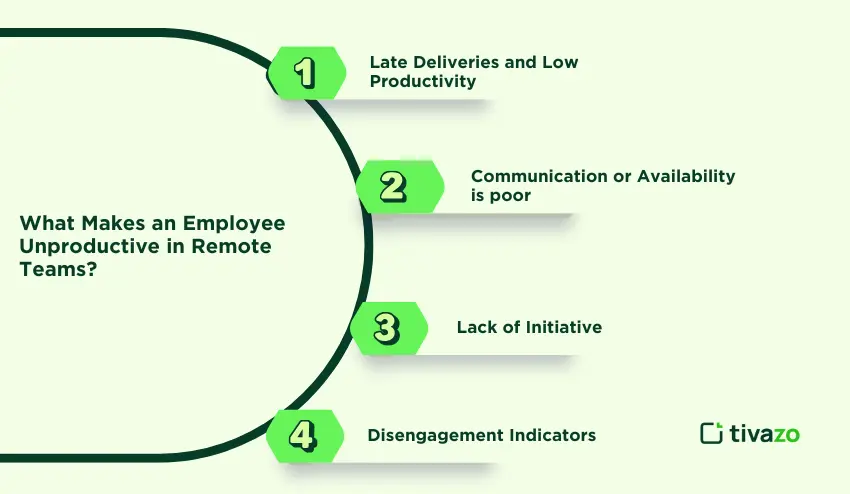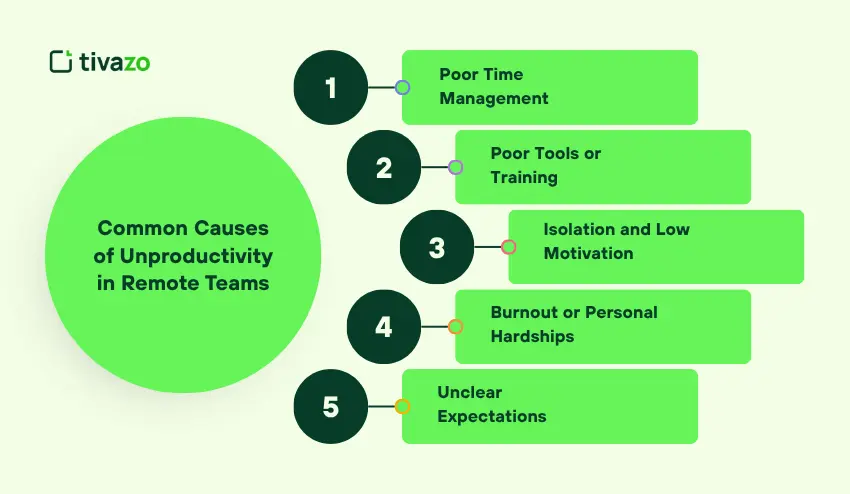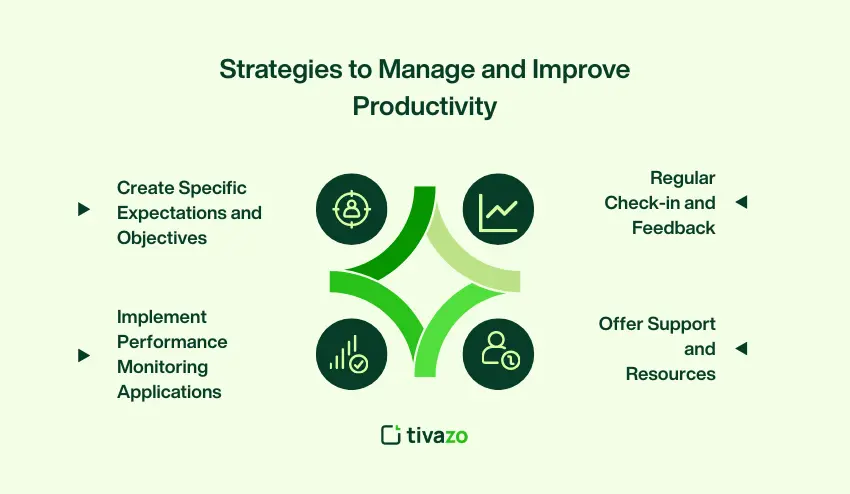Handling of unproductive employees in a remote workforce has turned out to be one of the greatest problems facing managers and business owners. In the absence of physical supervision, it may be hard to identify struggling, disengaged, and lagging employees. A non-productive employee does not only influence his or her performance, but also their actions may spread to the rest of the team, slowing down the projects, demotivating, and influencing the overall performance of the business.
Telecommuting needs a new management style. The old systems of tracking the number of hours or even physical presence are no longer relevant, and leaders have to resort to trust, communication, and clear expectations. It is important to deal with unproductive employees sooner because the situation can be worsened by the lack of attention, and performance issues might become even bigger.
The guide offers insights that are practical to managers and owners to find out unproductive workers, the underlying reasons, effective ways of measuring performance, and strategies that can be used to improve productivity and engagement in remote teams.
What Makes an Employee Unproductive in Remote Teams?
In a remote environment, identifying unproductive employees requires more than just checking who is logged in or attending meetings. Remote team productivity is based on outcomes, involvement and regular contribution to the team objectives. Knowledge of the exact behaviors that signify an ineffective employee assists managers to act before things get out of hand.

1. Late Deliveries and Low Productivity.
It is one of the most obvious indicators of an unproductive employee when he/she is always late or does poor work. Remote workers might have issues with self-management or prioritization, so the tasks will accumulate or the projects will be postponed. The inability of an unproductive employee to meet deadlines on a regular basis affects the overall working process of the team and the satisfaction of clients.
2. Communication or Availability is poor.
Digital communication is critical in remote work. Unproductive employees often fails to respond to emails, messages, or meeting invites promptly. Unavailability or slow responses may put stagnation on projects, cause confusion and frustrations among team members, who need updates on time.
3. Lack of Initiative
A poor worker can shirk responsibilities or even fail to come up with ideas. They are waiting to be instructed on what to do as opposed to taking initiative on issues. This action might eventually slow innovation and the overall pace of the team.
4. Disengagement Indicators
Disengagement is a subtle but critical sign of unproductive employees. This may involve having a low level of involvement in team meetings, not collaborating or not being keen on the objectives of the company. Low enthusiasm toward new projects may also be seen among disengaged employees and this may affect the morale of the whole remote team.
Common Causes of Unproductivity in Remote Teams
Understanding why unproductive employees struggle is key to addressing the issue effectively. Telecommuting is a unique problem that can lead to ineffective performance unless handled with caution.

1. Poor Time Management.
Many remote workers cannot organize their day without direct supervision. Failure to manage time effectively can result in missing deadlines, incomplete tasks and lateness. Unproductive employees may spend excessive time on low-priority tasks while critical work is delayed, reducing overall team efficiency.
2. Poor Tools or Training.
Unproductive employees often lack access to proper tools or sufficient training to perform tasks efficiently. Even the motivated employees will not be able to keep pace without the relevant software, systems, or skills. The managers are supposed to ensure that the members of the remote team are equipped to succeed.
3. Isolation and Low Motivation.
Isolation can also be brought about by remote working. Unproductive employees may lose motivation when disconnected from colleagues or the company culture. The lack of engagement could be the reason of low level of effort, cooperation, and responsibility.
4. Burnout or Personal Hardships.
Stress, burnout, or distractions in personal life can be very influential in productivity. Unproductive employees may appear disengaged or unresponsive, not because of lack of skill, but due to mental or emotional strain. The knowledge of these factors will help managers respond positively instead of reprimanding them immediately.
5. Unclear Expectations
The workers will not have clear objectives, key performance indicators, and duties which may make them not know what is expected of them. Unproductive employees often struggle in environments where priorities are vague or instructions are inconsistent. Clear communication of expectations has to be in place to prevent confusion and poor performance.
By finding out the causes of unproductivity, the managers will be able to develop interventions that will not only correct the behavior but also the challenges that are behind the behavior. This will help to prevent the occurrence of similar issues and encourage the effectiveness of remote teams over time. managers can tailor interventions to address both behavior and underlying challenges. This approach helps prevent recurring issues and supports long-term productivity for remote teams.
Identifying Unproductive Employees Early
Finding employees who are unproductive early is crucial for maintaining team efficiency and preventing larger performance issues. Clear metrics, patterns of communication, and engagement signs should guide one in remote teams, where the managers lack the opportunity to observe the day-to-day behavior.
1. Performance Metrics
Tracking output and results helps identify unproductive employees objectively. The managers will monitor the pace at which the tasks are completed, quality of work and on-time project completion. The inability to compete with other students due to constant underperformance can be an indicator of the need of intervention.
2. Engagement Signals
Active participation in meetings, responsiveness to messages and collaboration are very high indicators of engagement. Unproductive employees often show reduced participation, delayed responses, or minimal contribution to discussions.
3. Behavior Patterns
Behavioral signs such as the presence of constant excuses, lack of responsibility, or lack of initiative can be used to identify unproductive employee. Documenting these trends over time will provide a history to coaching conversations or improvement of performance.
Case Example
Consider an example of a remote marketing team where one of the team members never meets the deadline and seldom attends team calls. The manager followed the trends of outputs and engagement of the employee in a month and found out that the employee was not productive and needed certain help, including establishing clearer goals and regular check-ins. The productivity was increased after a few weeks. Over a month, the manager identified the employee as unproductive and implemented targeted support, including clearer goals and regular check-ins. Within weeks, productivity improved significantly.
How to Measure Productivity in Remote Teams
Measuring productivity in remote teams is essential to identify unproductive employees and support their improvement. In contrast to the conventional office environment, remote work needs objective and equitable measures that include output and engagement.
1. Quantitative Metrics
Quantitative measures are concerned with practical outcomes. Managers have an opportunity to monitor the activities done, the due dates, project milestones, and KPIs. Monitoring these metrics over time highlights patterns and helps identify unproductive employees who consistently underperform compared to expectations.
2. Qualitative Metrics
Productivity cannot always be quantified. Qualitative measures are peer feedback, quality of collaboration, initiative and problem-solving skills. A worker can deliver outcomes and at the same time be unproductive, when he or she does not help in building a team or creating innovations.
3. Time Management Metrics
Learning the way employees use their working time may indicate inefficiencies. Metrics such as active work hours, focus time, and project timelines help managers pinpoint unproductive employees who may be spending excessive time on low-priority tasks or failing to meet deadlines efficiently.
4. Balanced Assessment
It is perilous to base on one measure. To have a clear picture of the performance, managers are advised to integrate quantitative, qualitative and time management indicators. This is a balanced methodology that will allow consideration of all perspectives and deliver practical information to enhance productivity.gers should combine quantitative, qualitative, and time management indicators to get a holistic view of performance. This balanced approach ensures fair evaluation and provides actionable insights to improve productivity.
Strategies to Manage and Improve Productivity
Organized strategies that entail combination of clear expectations, support, and accountability are to be employed to address unproductive employees working in remote teams. The strategies also contribute to the performance improvement, but do not demoralize the team.

1. Create Specific Expectations and Objectives.
Clear and proper goals and responsibilities are required. The deliverables, deadlines, and quality standards should be communicated by the managers to ensure that unproductive employees are aware of what is expected. Perhaps it will be more appropriate to break down bigger projects into smaller milestones to make the tasks easier to manage and measure.
2. Implement Performance Monitoring Applications.
It is also necessary to monitor progress regardless of the lack of micromanagement. Such tools as project management software or shared dashboard can be used by the managers in order to monitor the output and observe the patterns. This openness helps to identify the employees who are not effective and areas where additional directives may be needed.
3. Regular Check-in and Feedback.
The problems in the first stages can be resolved with the help of regular individual meetings and progress reports. The positive feedback will make sure that an unproductive employee is aware of where he or she is not doing it and how to improve it and entrenching positive behaviors.
4. Offer Support and Resources.
Sometimes inadequacy of skills or resources is a contributing factor to unproductivity. The unproductive employees can be improved through training, mentoring or provision of the appropriate tools to enable them to perform better. By offering the workers what they need, frustration will be reduced and confidence will be boosted.s can contribute to unproductivity. Managers should maintain open communication and offer flexibility or support when needed. Understanding underlying challenges helps unproductive employees overcome obstacles and regain focus.
Examples of Unproductive Behavior and How to Handle Them
It is easier to deal with unproductive employees in remote teams since it is easy to identify the behaviors. Both the problem and solutions to the problem are demonstrated in real-life examples.
1. Ignoring Deadlines
A non-productive worker can always be late with work, which interferes with the schedules of teamwork and customer promises.
How to manage it: Have definite deadlines, monitor progression with project management tools and provide constructive feedback. Divide big tasks into small milestones in order to make the deadlines manageable.
2. Poor Communication
Other ineffective employees hardly reply to messages or attend meetings and this causes confusion and delays.
How to manage it: Set communication rules, e.g. time limits of responding to emails and chat messages. Make frequent visits and promote openness to keep the employee in touch.
3. Avoiding Collaboration
A non-productive employee can either seclude himself/herself during team discussion or not contribute to any project.
Management: Engage in active involvement by giving the employee collaborative tasks and partnering him with active teammates. Give comments on the significance of teamwork and acknowledge teamwork.
4. Lack of Initiative
Stagnant projects can be stalled by employees who take action only after being given orders.
How to manage it: There should be clear roles and responsibilities and employees should be able to make decisions within their areas. Provide instructions on problem-solving and reinforce proactive behavior as a way of encouraging change.
5. Disengagement
Indications of disengagement would be a lack of involvement in meetings, lack of interest in company objectives or lack of interest in projects.
How to manage it: Have one-on-one talks to know the root causes, support or mentor, and engage the employee in the decision-making process that fits their interests and strengths.
Preventing Unproductivity in Remote Teams
- Onboarding and Training Programs: Be specific and have expectations and orientation to workflow and company culture to minimize confusion and disengagement.
- Procedures of Formal Communication: There are guidelines of behavior of how team members will relate, report and respond to one another to make sure that there is coordination within the team.
- Goal-Setting and Periodic Reviews: Does KPIs, milestones, and feedback loops: to make sure that nothing goes wrong, and unproductive employees are identified when it is still possible.
- Remote Work Culture: Remote working involves creation of cooperation, performance rewarding and team building to ensure that the employees are both motivated and engaged.
- Work together and be Open with Technology: Monitor progress and avoid delays without micromanagement using project management and collaboration software.
Differentiating Between Unproductivity and Lack of Skill
In dealing with unproductive employees it is important to know whether the problem is in the form of poor attitude or it is merely a lack of skill. To distinguish the difference, here is how to do it:
Lack of Skill:
- Still, employees work hard and fail to achieve expectations.
- They commit a lot of errors or require more time to accomplish tasks.
- They are receptive to criticism and willing to study.
- Guidance or training results in a significant improvement in performance.
Unproductivity :
- Employees shun work or are not keen on work.
- They are not receptive to criticism and do not deliver on time without justifiable reasons.
- They have minimal communication and tend to lose interest in the team.
- It does not really improve even after support or coaching.
These differences enable managers to make the right decision, which is to train and mentor skill deficiencies, and provide explicit expectations and accountability on behaviour problems.
Conclusion
Dealing with unproductive workers in virtual teams takes time, understanding, and effective planning. It is not always only about laziness, in many cases, it is a combination of vague expectations, communication failures, or disassociation with the objectives of the company. Managers can bring employees back to track by establishing the root cause at an early stage rather than allowing performance to creep quietly.
Good leadership involves the ability to coach, train and make tough decisions. Even a deadweight employee can be a productive part of your remote team through regular feedback, goals and goals, and open communication.




